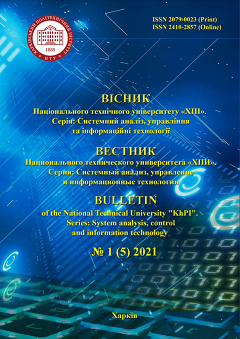SIMULATION OF VIRTUAL DISTRIBUTED PRODUCTION LOCATION UNDER CONDITIONS OF LIMITED POSSIBILITIES OF ENTERPRISE DEVELOPMENT
DOI:
https://doi.org/10.20998/2079-0023.2021.01.07Abstract
The task to research the enterprises when locating them in the new areas is posed and solved. The relevance of the problem is related to both moral and physical aging of production systems, which leads to the need for their modernization and reengineering. For the development of the enterprise, new areas are required to accommodate modern technological equipment. Due to the diversification of the company's activities and the appearance of new orders, it is advisable to place modern production lines with a high degree of automation in new areas. The requirements for the organization of new industries, taking into account the concept of Industry 4.0, have led to the creation of enterprises in the form of virtual industries focused on the creation of new innovative products. The aim of the work is to develop models for the rational location of virtual production in the new areas in conditions of limited enterprise capabilities. Due to the complexity of the problem being solved, the study is carried out in three stages: optimization of location on the earth's surface; creation of the communication infrastructure for virtual production; simulation of the virtual enterprise production cycle. The efficient location of virtual production is carried out using both local and multicriteria optimization. In order to create the communication infrastructure of the virtual enterprise the selection of the optimal route for highway laying is carried out. Simulation of the production cycle is carried out considering time delays and queues when performing technological operations. The new scientific result is the solution of the problem of virtual production system locating on the earth's surface, taking into account the proposed indicators and restrictions, which include the cost of land plots renting (acquiring), as well as the costs associated with earth and construction works. Mathematical methods were used: integer optimization, simulation modeling, agent-based modeling.
Keywords: virtual enterprise, optimization of technological objects location, communication infrastructure of the enterprise, simulation modeling, agent-based modeling.
References
Lindgren M., Bandhold H. Scenario Planning The link between future and strategy. Palgrave Macmillan UK, 2002. 180 p. DOI: https://doi.org/10.1057/9780230511620.
Uskenbayeva R. K., Kurmangaliyeva B. K., Yedilkhan D. Situational Management for Process Implementation of Working Operations of the Business Process. 54th Annual Conference of the Society of Instrument and Control Engineers of Japan (SICE), Hangzhou, China, 2015, pp. 292–297. DOI: https://doi.org/10.1109/SICE.2015.7285573.
Paulsen S., Boens J. Summary of the Workshop on information and communication technologies supply chain risk management. National Institute of Standarts and Technology, 2012. 21 p.
Fedorovich O., Uruskiy O., Pronchakov Yu., Lukhanin M. Method and information technology to research the component architecture of products to justify investments of high-tech enterprise. Radioelektronni i komp'yuterni systemy - Radio electronic and computer systems. 2021, vol. 1 (79), pp. 150–157. DOI: https://doi.org/10.32620/reks.2021.1.13
Xu X. et al. Transportation network redundancy: Complementary measures and computational methods. Transportation Research Part B: Methodological. 2018, vol. 114, pp. 68–85.
Fedorovich O. E., Pronchakov Yu. L. Metod formuvannya lohistychnykh transportnykh vza-yemodiy dlya novoho portfelyu zamovlenʹ rozpodileno-ho virtualʹnoho vyrobnytstva [Method of formation of logistic transport interactions for a new portfolio of orders of distributed virtual production]. Radioelektronni i komp'yuterni systemy - Radio electronic and computer systems. 2020, no. 2, pp. 102–108
Pawluczuk Ju. K probleme upravleniya proizvodstvennymi resursami predpriyatiya [Problemy zarządzania zasobami produkcyjnymi przedsiębiorstwa]. Zarządzanie: Teoria i praktyka, 2011, no. 1 (3), pp. 17–26.
Roszak M. T. Zarządzanie jakością w praktyce inżynierskiej. Open Access Library. 2014, vol. 1 (31). 150 p.
Nakonechny O. Analiz umov ta faktoriv, shcho vplyvayutʹ na efektyvnistʹ funktsionuvannya systemy lohistyky syl oborony derzhavy [Analysis of conditions and factors influencing the efficiency of the logistics system of the state defense forces]. Systemy upravlinnya, navihatsiyi ta zvyazku. Zbirnyk naukovykh pratsʹ. 2019, vol. 3, no. 55, pp. 48–57.
Kostina L. P. Metod resheniya zadachi optimal'nogo raspredeleniya resursov na stokhasticheskikh setyakh so slozhnoy prostranstvennovremennoy strukturoy [Method for solving the problem of optimal resource allocation on stochastic networks with a complex space-time structure]. Vestnik Sankt-Peterburskogo universiteta. 1992, iss. 3, no. 15, pp. 36–43.
Mouder J., Elmagrabi S. ed. Issledovaniye operatsiy. Vol. 2. [Operations Research]. Moscow, Mir Publ., 1981. 677 p.
Kravets P. O. Dynamichna koordynatsiya stratehiy mulʹtyahentnykh system [Dynamic coordination of multi-agent systems strategies]. Bulletin of the National University "Lviv Polytechnic"/ 2011, no. 699, pp. 134–144.
Downloads
Published
How to Cite
Issue
Section
License
LicenseAuthors who publish with this journal agree to the following terms:
- Authors retain copyright and grant the journal right of first publication with the work simultaneously licensed under a Creative Commons Attribution License that allows others to share the work with an acknowledgement of the work's authorship and initial publication in this journal.
- Authors are able to enter into separate, additional contractual arrangements for the non-exclusive distribution of the journal's published version of the work (e.g., post it to an institutional repository or publish it in a book), with an acknowledgement of its initial publication in this journal.
- Authors are permitted and encouraged to post their work online (e.g., in institutional repositories or on their website) prior to and during the submission process, as it can lead to productive exchanges, as well as earlier and greater citation of published work (See The Effect of Open Access).


